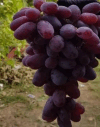Exogenous phenylalanine application effects on phytochemicals, antioxidant activity, HPLC profiling, and PAL and CHS genes expression in table grapes (Vitis vinifera cv. 'Qzl Ouzum')
- PMID: 39701999
- PMCID: PMC11657284
- DOI: 10.1186/s12870-024-05934-4
Exogenous phenylalanine application effects on phytochemicals, antioxidant activity, HPLC profiling, and PAL and CHS genes expression in table grapes (Vitis vinifera cv. 'Qzl Ouzum')
Abstract
Background: Grape (Vitis vinifera L.) is one of the most important fruit products globally and has a high nutritional value with potent antioxidant and anti-cancer activities. In current years, phenylalanine application has been particularly noticed for enhancing the nutritional quality of horticultural crops. With the aim of quality improvement, the effects of foliar application of phenylalanine at 5 concentrations (0, 100, 500, 1000, and 2000 μM) on Vitis vinifera cv. 'Qzl Ouzum' berry compositions were studied. The studied parameters included antioxidant activity, phenolics, flavonoids, anthocyanin, catalase and phenylalanine ammonia-lyase enzyme activity, and phenolic compounds content based on HPLC analyses (myricetin, quercetin, kaempferol, syringetin, catechin, gallic acid, caffeic acid, p-coumaric acid, resveratrol).
Results: Phenylalanine at 1000 μM increased total phenols, flavonoids, anthocyanins, and PAL enzyme activity. In addition, HPLC analysis revealed a significant accumulation of individual phenolic compounds by phenylalanine treatment. The highest values were recorded in the treatments with 100 and 500 μM phenylalanine for most of the phenolic components. Real-time quantitative RT-PCR results showed that the expression of PAL and CHS genes was induced by phenylalanine. The highest PAL and CHS gene expression was observed at 500 μM and then at 1000 μM phenylalanine treatment.
Conclusions: With the use of phenylalanine, the activity of the PAL and CHS enzyme and PAL and CHS gene expression were significantly increased and led to a greater accumulation of phenolic compounds and antioxidant activiety. This study suggests that the use of phenylalanine as a main precursor for the synthesis of phenolic compounds, can improve the phenolic composition of grapes and could be a practical approach to advance fruit quality in the production of grape cv. 'Qzl Ouzum'.
Keywords: PAL and CHS genes; Antioxidant capacity; Phenolic compounds; Phenylalanine; Phenylalanine ammonia-lyase.
© 2024. The Author(s).
Conflict of interest statement
Declarations. Ethics approval: The study was conducted with the explicit permission of the vineyard owner. Consent to participate: Not Applicable. Consent for publication: Not Applicable. Competing interests: The authors declare no competing interests.
Figures




Similar articles
-
Pre-véraison treatment of salicylic acid to enhance anthocyanin content of grape (Vitis vinifera L.) berries.J Sci Food Agric. 2019 Oct;99(13):5946-5952. doi: 10.1002/jsfa.9869. Epub 2019 Jul 10. J Sci Food Agric. 2019. PMID: 31206683
-
Anthocyanin, antioxidant activity and stress-induced gene expression in high CO2-treated table grapes stored at low temperature.J Plant Physiol. 2008;165(5):522-30. doi: 10.1016/j.jplph.2006.12.011. Epub 2007 Jun 13. J Plant Physiol. 2008. PMID: 17570561
-
Regulating the secondary metabolism in grape berry using exogenous 24-epibrassinolide for enhanced phenolics content and antioxidant capacity.Food Chem. 2013 Dec 1;141(3):3056-65. doi: 10.1016/j.foodchem.2013.05.137. Epub 2013 Jun 7. Food Chem. 2013. PMID: 23871059
-
Exogenous melatonin and salicylic acid enhance postharvest quality and boost antioxidant capacity in Vitis vinifera cv. 'Cuibao seedless' grape berries.Plant Physiol Biochem. 2025 Jun;223:109850. doi: 10.1016/j.plaphy.2025.109850. Epub 2025 Mar 27. Plant Physiol Biochem. 2025. PMID: 40184905
-
Phytochemistry, Anti-cancer, and Anti-diabetic Properties of Plant-Based Foods from Mexican Agrobiodiversity: A Review.Foods. 2024 Dec 23;13(24):4176. doi: 10.3390/foods13244176. Foods. 2024. PMID: 39767118 Free PMC article. Review.
Cited by
-
Biofortified Calcium Phosphate Nanoparticles Elicit Secondary Metabolite Production in Carob Callus via Biosynthetic Pathway Activation.Plants (Basel). 2025 Jul 8;14(14):2093. doi: 10.3390/plants14142093. Plants (Basel). 2025. PMID: 40733330 Free PMC article.
-
Copper Sulfate Elicitation Effect on Biomass Production, Phenolic Compounds Accumulation, and Antioxidant Activity of Morus nigra L. Stem Node Culture.Plants (Basel). 2025 Mar 2;14(5):766. doi: 10.3390/plants14050766. Plants (Basel). 2025. PMID: 40094754 Free PMC article.
References
-
- Garde-Cerdan T, Lopez R, Portu J, Gonzalez-Arenzana L, Lopez-Alfaro I, Santamaria P. Study of the effects of proline, phenylalanine, and urea foliar application to tempranillo vineyards on grape amino acid content. Comparison with commercial nitrogen fertilizers. Food Chem. 2014;163:136–41. 10.1016/j.foodchem.2014.04.101 - PubMed
-
- Chassy AW, Douglas OA, Waterhouse AL. Tracing phenolic metabolism in Vitis vinifera berries with 13C6–phenylalanine: implication of an unidentified intermediate. J Agric Food Chem. 2014;62:2321–6. 10.1021/jf402229u - PubMed
-
- Aghaei K, Ghasemi Pirbalouti A, Mousavi A, Naghdi Badi H, Mehnatkesh A. Effects of foliar spraying of L-phenylalanine and application of bio-fertilizers on growth, yield, and essential oil of hyssop [Hyssopus officinalis L. Subsp. Angustifolius (Bieb)]. Biocatal Agric Biotechnol. 2019;21:101318. 10.1016/j.bcab.2019.101318
-
- Portu J, López-Alfaro I, Gómez-Alonso S, López R, Garde-Cerdán T. Changes on grape phenolic composition induced by grapevine foliar applications of phenylalanine and urea. Food Chem. 2015;180:171–80. 10.1016/j.foodchem.2015.02.042 - PubMed
MeSH terms
Substances
LinkOut - more resources
Full Text Sources
Medical

